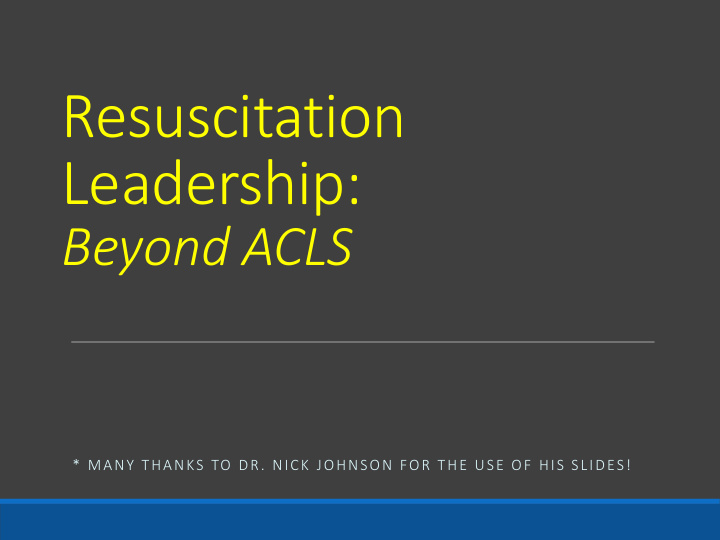



Resuscitation Leadership: Beyond ACLS * MANY THANKS TO DR. NICK JOHNSON FOR THE USE OF HIS SLIDES!
Get in the Right Mindset: Control Self Patient
Get in the Right Mindset: Control Self Team Environment Patient Cliff Reid, Making things Happen, 2013
Preparation ACLS is just the beginning ◦ Know the algorithms ◦ References are OK! ◦ Start out strong: checklist/script for the first 30-60 seconds ◦ Have a plan: common scenarios ◦ Practice, practice, practice
Prepare yourself even MORE Know your resources ◦ Team ◦ Back up ◦ Equipment Navigate the hospital
Team
Prepare your team Pre-brief On-the-fly drills Mock codes “Practice as you play”
Controlling the Team & Environment: Leadership Best Practices
The Ultimate Code Team Leader Clear introductions Be loud, be calm, be nice Body language Delegate ◦ Crowd control ◦ Getting a hx ◦ Pulse checker
Back to our scripts …
Troublesome Codes: Be Prepared
Common Hang-ups: Have a Plan The “not -a- code” code Awkward location The overly-enthusiastic fellow Vascular access issues Airway difficulties The über sub-specialty patient
Challenging Scenarios
Case #1
Case #2
Surgical Airway Code Case #2 ◦ The patient cannot be oxygenated or ventilated. ◦ The patient needs a definitive airway without delay and any of the triggers outlined below are met. ◦ 3 attempts at endotracheal intubation and/or ◦ 10 minutes has elapsed ◦ The Anesthesiology attending physician or the Code Blue Team Leader decides that a surgical airway is necessary and additional intubation attempts would be futile.
Case #2
Case #2
For sub-specialty patients, ask for sub-specialty help Cardiac device patient in extremis: • Vital signs may be unreliable • Can closed-chest compressions performed? • Is the device working? • Is the patient hypovolemic? • Is there bleeding or thrombosis? Case #2
Recommend
More recommend